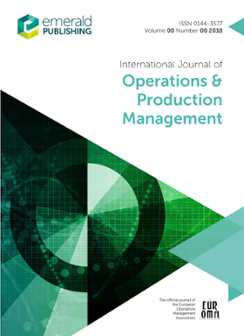供应网络和内部网络之间的相互作用:绩效影响
IF 7.1
2区 管理学
Q1 MANAGEMENT
International Journal of Operations & Production Management
Pub Date : 2021-05-15
DOI:10.1108/IJOPM-10-2020-0710
引用次数: 4
摘要
目的供应网络对企业绩效的重要性已得到充分证明。到目前为止,该公司及其供应商一直被概念化为单一实体。然而,跨国公司是由一个复杂的、地理上分散的内部子公司网络组成的。供应和内部网络有着内在的联系。本研究的目的是调查这些网络的相互作用对公司层面财务绩效的影响。设计/方法论/方法基于供应网络、内部网络和双重嵌入性研究,作者使用FactSet的供应网络数据和Orbis的内部网络数据研究了这些网络的相互作用。我们使用公司层面的财务绩效、两个网络之间的物理接近度和内部网络的地理分散度来评估跨国公司层面的影响。研究结果表明,企业与其供应网络的物理邻近性的绩效效应受到企业内部网络的地理分散性的负调节。这种影响可以追溯到企业资产的边际盈利能力下降。此外,由于管理复杂子公司网络的运营挑战,单个子公司的双重嵌入带来的好处在公司层面是有代价的。研究局限性/含义本研究首次同时调查跨国公司的供应和内部网络。原创性/价值本文通过考虑焦点公司及其供应商的内部网络,扩展了供应网络文献。本文是第一批了解焦点公司的供应和内部网络之间的互动以及对财务绩效的影响的研究之一。本文章由计算机程序翻译,如有差异,请以英文原文为准。
The interaction between supply networks and internal networks: performance implications
PurposeThe importance of the supply network to firm performance is well documented. Until now, the firm and its suppliers have been conceptualized as single entities. Yet, multinational corporations (MNCs) are composed of a complex, geographically dispersed internal network of subsidiaries. The supply and internal networks are inherently linked. The purpose of this study is to investigate the impact of the interaction of these networks on firm-level financial performance.Design/methodology/approachBuilding on supply network, internal network and dual embeddedness research, the authors investigate the interaction of these networks using supply network data from FactSet and internal network data from Orbis. We assess the impact at the MNC level, using measures of firm-level financial performance, physical proximity between the two networks and geographic dispersion of the internal network.FindingsThe results show that the performance effect of physical proximity of the firm with its supply network is negatively moderated by the geographic dispersion of the firm's internal network. This effect can be traced back to the diminishing marginal profitability of a firm's assets. Moreover, the benefits of dual embeddedness to the individual subsidiary come at a cost at the firm-level due to the operational challenges of managing a complex subsidiary network.Research limitations/implicationsThis study is the first to investigate the supply and internal networks of MNCs simultaneously.Originality/valueThe paper extends supply network literature by considering the internal network of the focal firm and its suppliers. This paper is one of the first studies that offer an understanding of the interaction between supply and internal networks of a focal firm and the effect on financial performance.
求助全文
通过发布文献求助,成功后即可免费获取论文全文。
去求助
来源期刊
CiteScore
13.30
自引率
17.20%
发文量
96
期刊介绍:
The mission of the International Journal of Operations & Production Management (IJOPM) is to publish cutting-edge, innovative research with the potential to significantly advance the field of Operations and Supply Chain Management, both in theory and practice. Drawing on experiences from manufacturing and service sectors, in both private and public contexts, the journal has earned widespread respect in this complex and increasingly vital area of business management.
Methodologically, IJOPM encompasses a broad spectrum of empirically-based inquiry using suitable research frameworks, as long as they offer generic insights of substantial value to operations and supply chain management. While the journal does not categorically exclude specific empirical methodologies, it does not accept purely mathematical modeling pieces. Regardless of the chosen mode of inquiry or methods employed, the key criteria are appropriateness of methodology, clarity in the study's execution, and rigor in the application of methods. It's important to note that any contribution should explicitly contribute to theory. The journal actively encourages the use of mixed methods where appropriate and valuable for generating research insights.

 求助内容:
求助内容: 应助结果提醒方式:
应助结果提醒方式:


